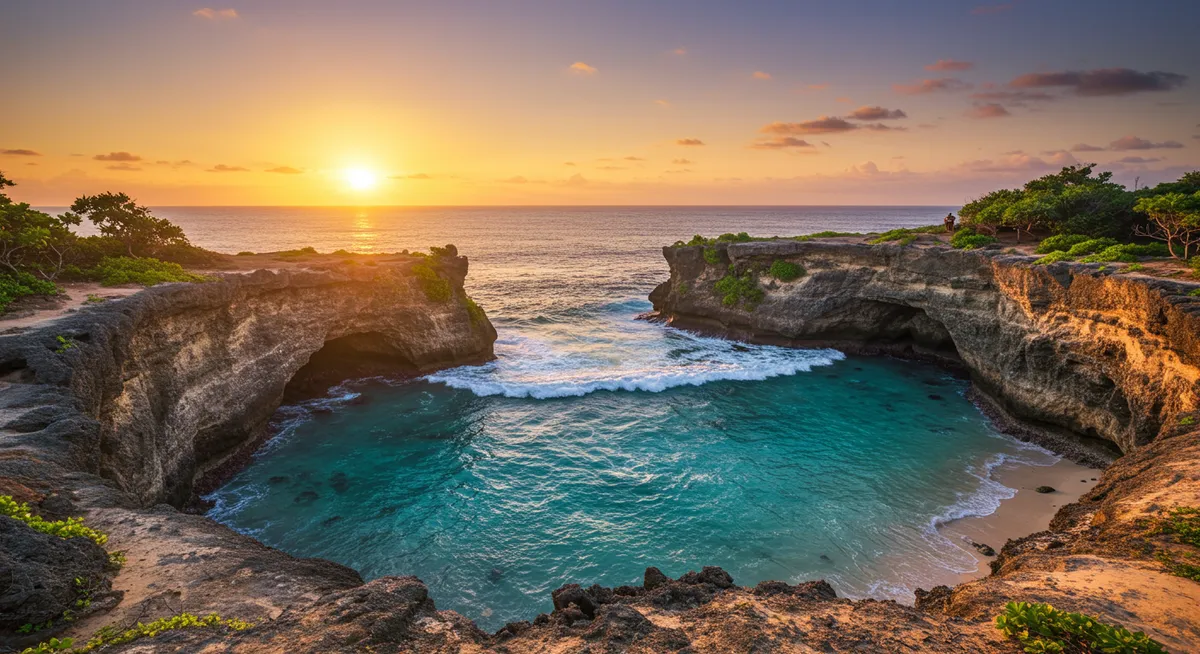
Devil's Tear Nusa Lembongan: Sunrise & Sunset Guide
Table of Contents
Want to find the best nature experiences for this destination? Chat with our nature tourism specialist!
Get Nature TipsCategory: devils-tear-nusa-lembongan-sunrise-and-sunset
Experiencing the Magic: Devil's Tear at Dawn and Dusk
Having explored Nusa Lembongan extensively, one of my absolute favorite natural spectacles is the dramatic Devil's Tear. This rugged limestone cove, famous for its powerful waves crashing into cliffs and creating impressive plumes of spray, offers a truly mesmerizing experience. While impressive throughout the day, the magic of Devil's Tear Nusa Lembongan reaches its peak during the golden hours of dawn and dusk. These moments not only transform the landscape with incredible light but also provide unique photographic opportunities. Join me as I share insights on how to best witness these unforgettable displays.
Capturing Devil's Tear Sunrise
Witnessing the Devil's Tear Nusa Lembongan sunrise is an incredibly serene and often less crowded experience. I've found that arriving just before 6:00 AM gives you ample time to find a good spot as the sky transitions from deep indigo to fiery orange and pink. The soft, directional light at this hour truly highlights the rugged textures of the cliffs and the ocean spray. It's a peaceful time, allowing you to appreciate the raw power of the ocean without the usual daytime bustle. From my experience, the eastern side offers the clearest view of the rising sun painting the horizon, creating a truly spectacular backdrop for the crashing waves. For more on the island's natural allure, explore other Nusa Lembongan nature attractions.
The Allure of Devil's Tear Sunset
The Devil's Tear Nusa Lembongan sunset is undeniably more popular, drawing crowds eager to witness the sun dip below the horizon, casting a golden glow over the dramatic coastline. Aim to arrive by 5:30 PM to secure a prime viewing spot, especially during peak season. The vibrant hues of the sunset reflecting on the powerful swells and the dramatic spray create an unforgettable, almost cinematic scene. This is a photographer's dream, with every crash of water illuminated by the fading light. A personal tip: linger for about 15-20 minutes after the sun disappears; the 'blue hour' offers stunning, ethereal light perfect for capturing the unique coastal landscape and its raw beauty. If you're a keen photographer, you might also find inspiration at the best beaches Nusa Lembongan for nature photography.
Safety and Photography Tips at Devil's Tear
While breathtaking, Devil's Tear demands respect for its raw power. Safety is paramount; never venture too close to the edge, especially during high tide or large swells, as rogue waves can be unpredictable. There are no barriers, so maintaining a safe distance is entirely your responsibility. For photography, a wide-angle lens is ideal to capture the expansive views and dramatic spray. Bring a sturdy tripod for stable shots, especially for long exposures during sunrise or sunset. My personal recommendation for capturing the perfect shot of Devil's Tear involves wearing sturdy footwear, as the rocks can be slippery. This stunning natural marvel is a highlight of any trip to this region, and you can discover more about incredible destinations on Tourist Nature.
Frequently Asked Questions
Is Devil's Tear dangerous?
What is the best time to visit Devil's Tear?
Are there other attractions near Devil's Tear?
Experiencing the Devil's Tear Nusa Lembongan sunrise and sunset is an essential part of any visit to this incredible island. These moments highlight the raw beauty and power of nature, offering breathtaking views and unforgettable photographic opportunities. Remember to prioritize safety by keeping a respectful distance from the crashing waves. Whether you choose the peaceful dawn or the vibrant dusk, Devil's Tear promises a truly awe-inspiring spectacle. Don't miss adding this natural wonder to your Nusa Lembongan itinerary to witness its captivating allure firsthand.